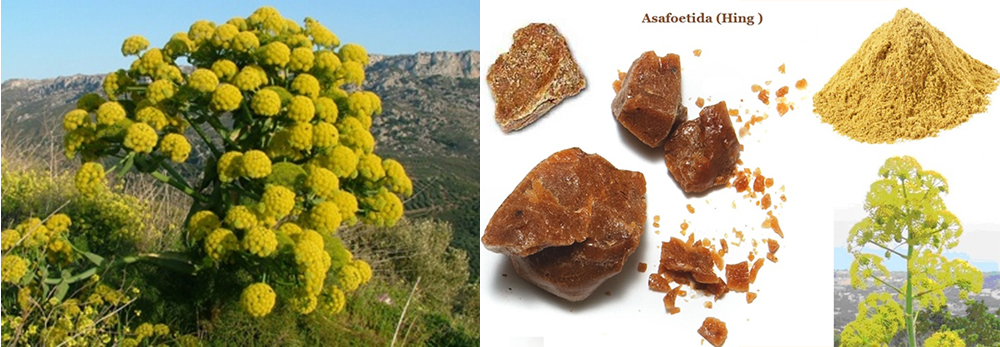HISTORY ASAFOETIDA
Asafoetida also spelled asafetida is the dried latex (gum oleoresin) exuded from the rhizome or tap root of several species of Ferula (F. foetida and F. assa-foetida), perennial herbs growing 1 to 1.5 m (3.3 to 4.9 ft) tall. They are part of the celery family, Umbelliferae. Notably, asafoetida is thought to be in the same genus as silphium, a North African plant now believed to be extinct, and was used as a cheaper substitute for that historically important herb from classical antiquity. The species are native to the deserts of Iran and mountains of Afghanistan where substantial amounts are grown. The common modern name for the plant in Iran and Afghanistan is badian, meaning: “that of gas or wind”, due to its use to relieve stomach gas.
Asafoetida has a pungent smell, lending it the trivial name of stinking gum, but in cooked dishes it delivers a smooth flavour reminiscent of leeks or other onion relatives. The odor dissipates upon cooking. Asafoetida is also known variously as “food of the devils”, “devil’s dung”, javoneh-i badian, hing, hengu, inguva, kayam, and ting.
USES OF ASAFOETIDA


This spice is used as a digestive aid, in food as a condiment, and in pickling. It plays a critical flavoring role in Indian vegetarian cuisine by acting as a savory enhancer.[7] Used along with turmeric, it is a standard component of lentil curries, such as dal, chickpea curries, and vegetable dishes, especially those based on potato and cauliflower. Asafoetida is used in vegetarian Punjabi and South Indian cuisine where it enhances the flavor of numerous dishes, where it is quickly heated in hot oil before sprinkling on the food. Kashmiri cuisine also uses it in lamb/mutton dishes such as Rogan Josh.[8] It is sometimes used to harmonise sweet, sour, salty, and spicy components in food. The spice is added to the food at the time of tempering. Sometimes dried and ground asafoetida (in small quantities) can be mixed with salt and eaten with raw salad.
In its pure form, it is sold in the form of chunks of resin, small quantities of which are scraped off for use. The odor of the pure resin is so strong that the pungent smell will contaminate other spices stored nearby if it is not stored in an airtight container.
History in the West
Asafoetida was familiar in the early Mediterranean, having come by land across Iran. Though it is generally forgotten now in Europe, it is still widely used in India. It emerged into Europe from an expedition of Alexander the Great, who, after returning from a trip to northeastern ancient Persia, thought they had found a plant almost identical to the famed silphium of Cyrene in North Africa—though less tasty. Dioscorides, in the first century, wrote, “the Cyrenaic kind, even if one just tastes it, at once arouses a humour throughout the body and has a very healthy aroma, so that it is not noticed on the breath, or only a little; but the Median [Iranian] is weaker in power and has a nastier smell.” Nevertheless, it could be substituted for silphium in cooking, which was fortunate, because a few decades after Dioscorides’ time, the true silphium of Cyrene became extinct, and asafoetida became more popular amongst physicians, as well as cooks.
Asafoetida is also mentioned numerous times in Jewish literature, such as the Mishnah. Maimonides also writes in the Mishneh Torah “In the rainy season, one should eat warm food with much spice, but a limited amount of mustard and asafoetida .
Asafoetida was described by a number of Arab and Islamic scientists and pharmacists. Avicenna discussed the effects of asafoetida on digestion. Ibn al-Baitar and Fakhr al-Din al-Razi described some positive medicinal effects on the respiratory system.
After the Roman Empire fell, until the 16th century, asafoetida was rare in Europe, and if ever encountered, it was viewed as a medicine. “If used in cookery, it would ruin every dish because of its dreadful smell,” asserted Garcia de Orta’s European guest. “Nonsense,” Garcia replied, “nothing is more widely used in every part of India, both in medicine and in cookery. All the Hindus add it to their food.” During the Italian Renaissance, asafoetida was used as part of the exorcism ritual.
IMAGES OF FERULA ASAFOETIDA


